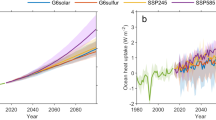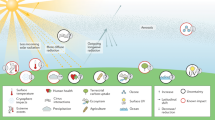Abstract
The risks and benefits of solar geoengineering, or solar radiation management (SRM), depend on assumptions about its implementation. Claims that SRM will reduce precipitation, increase ocean acidification or deplete stratospheric ozone, or that it must be continued forever once started, are not inherent features of SRM; rather, they are features of common scenarios for its implementation. Most analyses assume, for example, that SRM would be used to stop the increase in global temperature or restore temperature to pre-industrial values. We argue that these are poor scenario choices on which to base policy-relevant judgements about SRM. As a basis for further analysis, we provide a scenario that is temporary in that its end point is zero SRM, is moderate in that it offsets only half of the growth in anthropogenic climate forcing and is responsive in that it recognizes that the amount of SRM will be adjusted in light of new information.
This is a preview of subscription content, access via your institution
Access options
Subscribe to this journal
Receive 12 print issues and online access
$209.00 per year
only $17.42 per issue
Buy this article
- Purchase on Springer Link
- Instant access to full article PDF
Prices may be subject to local taxes which are calculated during checkout


Similar content being viewed by others
References
Robock, A. 20 reasons why geoengineering may be a bad idea. Bull. Atom. Sci. 64, 14–18 (2008).
Bala, G., Duffy, P. B. & Taylor, K. E. Impact of geoengineering schemes on the global hydrological cycle. Proc. Natl Acad. Sci. USA 105, 7664–7669 (2008).
Kleidon, A. & Renner, M. A simple explanation for the sensitivity of the hydrological cycle to surface temperature and solar radiation and its implications for global climate change. Earth Syst. Dynam. 4, 455–465 (2013).
Nordhaus, W. A Question of Balance: Weighing the Options on Global Warming Policies (Yale Univ. Press, 2008).
Keith, D. W. & Parker, A. The fate of an engineered planet. Sci. Am. 308, 34–36 (2013).
Meinshausen, M., Raper, S. C. B. & Wigley, T. M. L. Emulating coupled atmosphere–ocean and carbon cycle models with a simpler model, MAGICC6. Part 1: Model description and calibration. Atmos. Chem. Phys. 11, 1417–1456 (2011).
Kravitz, B. et al. The Geoengineering Model Intercomparison Project (GeoMIP). Atmos. Sci. Lett. 12, 162–167 (2011).
MacMartin, D. G., Keith, D. W., Kravitz, B. & Caldeira, K. Management of trade-offs in geoengineering through optimal choice of non-uniform radiative forcing. Nature Clim. Change 3, 365–368 (2013).
MacMartin, D. G., Kravitz, B., Keith, D. W. & Jarvis A. J. Dynamics of the couple human-climate system resulting from closed-loop control of solar geoengineering. Clim. Dyn. 43, 243–258 (2014).
MacMartin, D. G., Caldeira, K. & Keith, D. W. Solar geoengineering to limit rates of change, Phil. Trans. R. Soc. A 372, 20140134 (2014).
Smith, S. J. & Rasch, P. J. The long-term policy context for solar radiation management. Clim. Change 121, 487–497 (2013).
Moreno-Cruz, J., Ricke, K. & Keith, D. W. A simple model to account for regional inequalities in the effectiveness of solar radiation management. Clim. Change 110, 649–668 (2011).
Kravitz, B. et al. A multi-model assessment of regional climate disparities caused by solar geoengineering. Environ. Res. Lett. 9, http://dx.doi.org/10.1088/1748–9326/9/7/074013 (2014).
Weitzman, M. What is the damages function for global warming—and what difference might it make? Clim. Change Econ. 1, 57–69 (2010).
Goes, M., Tuana, N. & Keller, K. The economics (or lack thereof) of aerosol geoengineering. Clim. Change 109, 719–744 (2011).
Lempert, R. J., Schlesinger, M. E., Bankes, S. C. & Andronova, N. G. The impacts of climate variability on near-term policy choices and the value of information. Clim. Change 45, 129–161 (2000).
Anderson, J. G., Wilmouth, D. M., Smith, J. B. & Sayres, D. S. UV dosage levels in summer: Increased risk of ozone loss from convectively injected water vapor. Science 337, 835–839 (2012).
MacMynowski, D. G., Keith, D. W., Caldeira, K. & Shin, H-J. Can we test geoengineering? Energy Environ. Sci. 4, 5044–5052 (2011).
Diffenbaugh, N. S. & Field, C. B. Changes in ecologically critical terrestrial climate conditions. Science 341, 486–492 (2013).
Schloss, C. A., Nuñez, T. A. & Lawler, J. J. Dispersal will limit ability of mammals to track climate change in the Western Hemisphere. Proc. Natl Acad. Sci. USA 109, 8606–8611 (2012).
Wigley, T. M. L. A combined mitigation/geoengineering approach to climate stabilization. Science 314, 452–454 (2006).
Matthews, H. D. & Caldeira, K. Transient climate-carbon simulations of planetary geoengineering. Proc. Natl Acad. Sci. USA 104, 9949–9954 (2007).
Stocker, T. F. & Schmittner, A. Influence of CO2 emission rates on the stability of the thermohaline circulation. Nature 388, 862–865 (1997).
Eliseev, A. V., Chernokulsky, A. V., Karpenko, A. A. & Mokhov, I. I. Global warming mitigation by sulphur loading in the stratosphere: dependence of required emissions on allowable residual warming rate. Theor. Appl. Climatol. 101, 67–81 (2010).
Pierce, J. R., Weisenstein, D. K., Heckendorn, P., Peter, T. & Keith, D. W. Efficient formation of stratospheric aerosol for climate engineering by emission of condensable vapor from aircraft. Geophys. Res. Lett. 37, L18805 (2010).
McClellan, J., Keith, D. W. & Apt, J. Cost analysis of stratospheric albedo modification delivery systems. Environ. Res. Lett. 7, 034019 (2012).
Heckendorn, P. et al. The impact of geoengineering aerosols on stratospheric temperature and ozone. Environ. Res. Lett. 4, 045108 (2009).
English, J. M., Toon, O. B. & Mills, M. J. Microphysical simulations of sulfur burdens from stratospheric sulfur geoengineering. Atmos. Chem. Phys. 12, 4775–4793 (2012).
Blackstock, J. J. et al. Climate Engineering Responses to Climate Emergencies (Novim, 2009); http://arxiv.org/pdf/0907.5140
Geels, F. W. From sectoral systems of innovation to socio-technical systems: Insights about dynamics and change from sociology and institutional theory. Res. Policy 33, 897–920 (2004).
Jones, C. A fast ocean GCM without flux adjustments. J. Atm. Ocean Technol. 20, 1857–1868 (2003).
Rinsland, C. P. et al. Post-Mount Pinatubo eruption ground-based infrared stratospheric column measurements of HNO3, NO, and NO2 and their comparison with model calculations. J. Geophys. Res. 108, 4437 (2003).
Author information
Authors and Affiliations
Corresponding author
Ethics declarations
Competing interests
The authors declare no competing financial interests.
Supplementary information
Supplementary information
A temporary, moderate and responsive scenario for solar geoengineering (PDF 285 kb)
Rights and permissions
About this article
Cite this article
Keith, D., MacMartin, D. A temporary, moderate and responsive scenario for solar geoengineering. Nature Clim Change 5, 201–206 (2015). https://doi.org/10.1038/nclimate2493
Received:
Accepted:
Published:
Issue Date:
DOI: https://doi.org/10.1038/nclimate2493
This article is cited by
-
A structural polymer for highly efficient all-day passive radiative cooling
Nature Communications (2021)
-
Potential implications of solar radiation modification for achievement of the Sustainable Development Goals
Mitigation and Adaptation Strategies for Global Change (2021)
-
Balancing a budget or running a deficit? The offset regime of carbon removal and solar geoengineering under a carbon budget
Climatic Change (2021)
-
Probing space to understand Earth
Nature Reviews Earth & Environment (2020)
-
Emerging risk governance for stratospheric aerosol injection as a climate management technology
Environment Systems and Decisions (2019)



